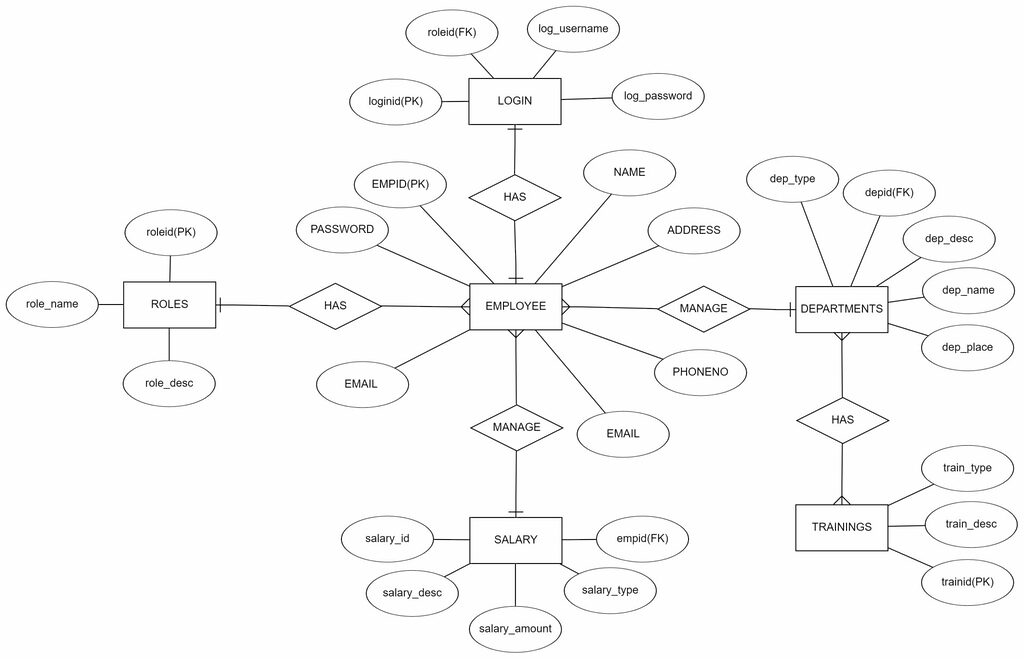In this article, We will discuss on how to create the ER Diagram for a Human Resource Management System.
The ERD of the Human Resource Management System shows all the tables and entity relationships between employees, salaries, training, and departments.
Furthermore, the most important parts of the ER diagram are employees, department, and salary.
It used structured data and relationships between structured data groups to define the functions of the Human Resource Management System.
What is an Entity Relationship Diagram?
The model of human resource management is represented by the entity relationship diagram (ER diagram).
entity of the system.
The entity-relationship diagram of the human resource management system displays all of the relevant information.
The graphical representation of the database tables and the connections between the many trainings, and departments It utilized structured data such as employee, salary, and other such things, and it defined the linkages between structured data.
Groupings of different functionalities for human resource management systems.
The fundamental components that make up human employees, training, departments, salaries, and salaries are all part of the resource management system.
About the Human Resource Management System
This article uses a case study of the Human Resource Management System (HRMS) in an organization to show how to build an Entity Relational Model (ERM).
It is made and written so that students can work through the HRMS business activities to learn how to make a conceptual model.
However, the Entity Relationship Diagram (ERD) is used to show how ERM is shown graphically. The following steps were taken:
- Identify, analyze, and refine the business rules. This was done by studying the business activities, gathering information, and finding the data elements by identifying the information’s needs, users, sources, and structure.
- Identify the main entities.
- Define the relationships between the entities.
- Complete the initial ERD. For each step, the process is explained and shown through examples and diagrams.
ER Diagram of Human Resource Management System
The ER Diagram of the Human Resource Management System shows the entities (data) that are part of the system and what they are thought to do (attributes).
Each of them was shown by a table that showed what they were like and how they related to each other.

Human Resource Management System ER Diagram Entities and Attributes
| Entities | Attributes |
|---|---|
| LOGIN | loginid(PK), roleid(FK), log_username, log_password |
| ROLES | roleid(PK), role_name, role_name |
| EMPLOYEE | empid(PK), name, address, phoneno, email, password |
| DEPARTMENTS | depid(FK), dep_name, dep_desc, dep_type, dep_place |
| SALARY | salary_id, empid(FK), salary_type, salary_amount, salary_desc |
| TRAININGS | trainid(PK), train_desc, train_type |
ER Diagram of Human Resource Management System Description
- The information about each employee is kept in the Employee tables.
- Each entity such as Login, Salary, Department, and Employee has its own primary key and foreign key.
- The entity department, Salary is linked to the entity Employee and Training with a foreign key.
- There are one-to-one and one-to-many relationships between Salary, Departments, Salary Slip, and Employee.
- All of the entities Employee, Salary, Department, and Salary have been normalized to reduce duplicate records.
Conclusion
A good database design is needed to make a database application that can be used to store and get data.
A good database design will make it easy to get data quickly and make it easier to use queries.
The conceptual design phase is the most important part of making a database.
During the requirement specification phase, data and information are gathered and used to make a data model.
This model is used in the conceptual design phase.
In this phase, the business and user needs are used to figure out what the functional requirements are and how the data model can meet them.
The DD will break down the users’ needs for the system or application into a set of entities, a set of attributes for each entity, and relationships between the entities.
This is the hardest thing for the DD to do when making a database.
Also, you may visit the link below for more information about diagrams.
- ER Diagram for Restaurant Management System
- Class Diagram for Employee Management System
- Use Case Diagram for Employee Management System
- Sequence Diagram of Employee Management System
- DFD for School Management System | Data Flow Diagram
- DFD for Employee Management System
